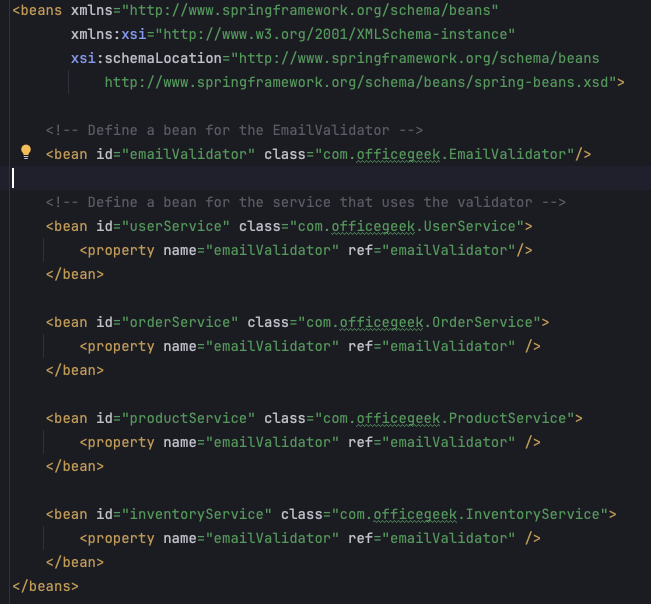
這樣的註解充滿了 Spring Boot 中的整個專案。
但是你知道這些註解解決了什麼問題嗎?
為什麼要引入自訂註解?
如何建立自訂註解?
今天,我將介紹:
在 Spring Boot 中,註解不僅僅是添加元資料的一種方式。他們
在 Spring 引入自訂註解之前,開發人員必須使用 XML 設定檔來管理電子郵件驗證等配置。
XML 設定將定義 bean、驗證器和其他必要的元件來執行驗證電子郵件地址等任務。
以下是如何在 Spring 應用程式中使用 XML 設定電子郵件驗證的範例:

如您所見,這很容易成為一場噩夢,因為有數百個類,其中許多類相互依賴。
這也意味著開發人員每次必須新增新的依賴項時都必須尋找此 XML。
Spring 引入了自訂註解來簡化配置,允許開發人員直接在程式碼中使用註解。
這減少了對大量 XML 配置的需求,使程式碼庫更乾淨且更易於維護。
Spring 中的自訂註解啟用了聲明式方法。
開發者可以使用@Transactional、@Cacheable或@Scheduled等註解來聲明所需的行為,而無需編寫底層邏輯。
這會產生更具可讀性和可維護性的程式碼。
Spring 的自訂註解通常與面向切面程式設計(AOP)一起使用,允許開發人員集中處理橫切關注點。
例如,@Transactional 註解可以跨多個方法或類別管理事務,而無需將事務管理邏輯分散在整個程式碼中。
它透過封裝常見行為減少了對樣板程式碼的需求。
例如,@Autowired 註解簡化了依賴注入,允許 Spring 自動注入依賴,而不需要明確的建構子或 setter 方法
是否應該使用 @Autowired 這是一個不同的討論。
Spring 透過將配置和橫切關注點抽象化為註解,提高了程式碼的可讀性。
您和您的同行開發人員可以透過查看方法或類別的註解來快速了解方法或類別的用途,並且註解有助於增強整個程式碼庫的一致性。
自訂註釋可讓開發人員根據特定需求建立客製化的註釋,從而以標準化的方式擴展框架的功能。
這種靈活性可幫助 Spring 在多個應用程式和架構中保持相關性和強大功能。
您可以使用 Spring 的 BeanPostProcessor、Aspect 或自訂註解處理邏輯來建立自訂邏輯來處理註解。
將自訂註解套用到定義的方法、欄位或類別。
package co.officegeek.tokenratelimiter; import org.springframework.stereotype.Service; @Service public class TestService { @LogExecutionTime public void serve() throws InterruptedException { // Simulate some work Thread.sleep(2000); } }

When you apply a custom annotation to a method, class, or field, the annotation itself doesn't directly cause any method to be called.
Instead, the logic associated with the annotation is typically implemented using reflection or aspect-oriented programming (AOP) in frameworks like Spring.
Here's a breakdown of how the compiler and runtime environment know what method to call when an annotation is applied:
Some annotations are handled at compile time by annotation processors.
Java's javax.annotation.processing package allows developers to create custom annotation processors that generate code, validate annotations, or even modify the abstract syntax tree (AST) of the code being compiled.
The annotation processor reads the annotations during compilation and executes code based on those annotations.
This can include generating new classes or methods that the code will use later.
The @Override annotation is a compile-time annotation that doesn't invoke a method but instead tells the compiler to check if the method actually overrides a superclass method.
Custom annotations can be processed at runtime using reflection.
The runtime system (e.g., a framework like Spring) uses reflection to detect the presence of annotations on methods, classes, or fields, and then applies the corresponding behavior.
A custom annotation like @LogExecutionTime doesn't directly trigger any method call.
Instead, an aspect or some other reflective mechanism checks for the presence of the annotation at runtime and then wraps the method call with additional logic.
In frameworks like Spring, AOP is commonly used to handle custom annotations.
AOP allows you to define "aspects" that can intercept method calls and perform additional processing before or after the method execution.
When the AOP framework (e.g. Spring AOP) detects an annotation, it triggers the execution of an advice method associated with the aspect.
This advice method contains the logic that the AOP framework executes when the annotated method is called.
A @Transactional annotation in Spring doesn't execute any logic by itself.
Instead, the Spring framework's AOP infrastructure intercepts calls to methods annotated with @Transactional and wraps them with transaction management logic.
Custom annotations are ideal for handling cross-cutting concerns like logging, security, transaction management, and caching.
These are concerns that affect multiple parts of an application but are not related to the core business logic.
上記の @LogExecutionTime アノテーションは、すべてのメソッドで使用でき、ビジネス ロジックを持たないため、良い例です。
どのように起こるかではなく、何が起こるかを指定したい場合、カスタム注釈を使用すると、これを行うためのクリーンで表現力豊かな方法が提供されます。
@Cacheable や @Retry のようなアノテーションを使用すると、開発者は実装コードを手動で記述することなく、宣言的にキャッシュを有効にしたり、ロジックを再試行したりできます。フレームワークまたはライブラリの統合
Spring の @Autowired のようなアノテーションは、依存関係を手動でインスタンス化することなく注入するのに役立ちます。
複雑なロジックのカプセル化
カスタム アノテーションを使用すべきではないユースケース
シンプルまたは一回限りのロジック
ユーザー入力または外部構成に基づいてメソッドの動作が変更される必要がある場合、カスタム アノテーションを使用してこれを処理すると、複雑な解決策につながる可能性があります。
コア ビジネス ロジックをカスタム アノテーションに抽象化しないでください。これにより、ロジックの透明性が低下し、保守が困難になる可能性があります。
@ProcessOrder などのビジネス プロセスをカプセル化するためにアノテーションを使用すると、重要なビジネス ルールが隠蔽され、コードの理解と保守が困難になる可能性があります。
動作が複数のアノテーション間の複雑な相互作用に依存している場合、予期しない結果が生じ、コードの理解とデバッグが困難になる可能性があります。
同じメソッドに影響を与える複数のカスタム アノテーション (@Retry、@Cacheable、@LogExecutionTime など) を組み合わせると、予期しない動作が発生する可能性があり、管理が困難になります
カスタム アノテーションはリフレクションまたはプロキシ メカニズムに依存することが多く、パフォーマンスのオーバーヘッドが発生する可能性があります。
パフォーマンスが重要なコードのセクションでは使用しないでください。
?概要 - カスタム注釈を使用する場合
カスタム アノテーションは、ロギング、セキュリティ、トランザクション管理などの横断的な問題の処理に最適です。
アプリケーションの複数の部分に同じ動作を適用する必要があるシナリオにも最適です。
実装を決定する前にトレードオフを検討してください。
?最終的な考え
カスタム アノテーションは Spring Boot の強力なツールですが、他のツールと同様に、慎重に使用する必要があります。
これらは、反復的なタスクを処理し、コードベース全体で一貫性を確保するためのクリーンで再利用可能な方法を提供します。
✅ レート制限アルゴリズムとその実装に関する深い知識
✅ Spring Boot の開発、テスト、コンテナ化のベスト プラクティス
でも、それは
についてでもあります✅ プロジェクトを特定のタスクに分割する
✅自分自身に責任を持つこと
✅ プロジェクトを適切に設計して構築する
ほとんどの企業に関連するユースケースであるマイクロサービスを設計および開発したいソフトウェア開発者を対象としています。
これは特に、「プロジェクトの経験」はないものの、多大な情熱と野心を持っている、ソフトウェア開発者のキャリアの初期の方に最適です。
これが役立つと思われる場合、または単に詳細を知りたい場合:
ご興味を登録していただければ、ワークショップの詳細をお知らせします。
これは最初に私のサブスタックで公開されました。まず更新情報を入手するには、私の Substack - Weekend Developer を購読してください。
あなたは自分が書いたコードについてのフィードバックが必要な開発者ですか?
それとも、あなたが正しいことをしているかどうかを誰かにレビューしてもらいたいですか?
私は、人々が早期にフィードバックを得て、より良いコードを書けるように、無料のコードレビューセッションを支援しています
Twitter (X) または LinkedIn で私に DM してください。コードについてお手伝いします。
以上是在 Spring Boot 中建立自訂註解的終極指南的詳細內容。更多資訊請關注PHP中文網其他相關文章!




